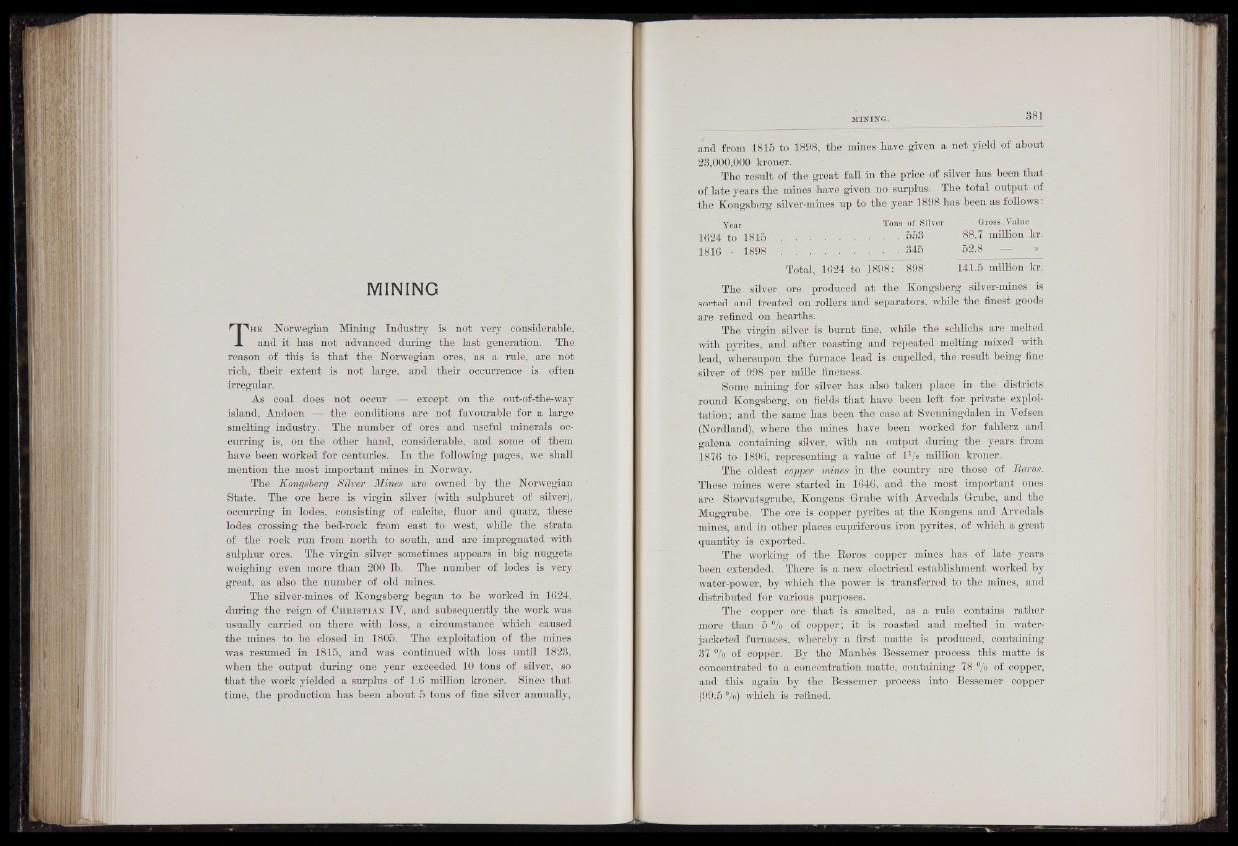
MINING
Th e Norwegian Mining Industry is not very considerable,
and it bas not advanced during tbe last generation. The
reason of this is that the Norwegian ores, as a rule, are not
rich, their extent is not large, and their occurrence is often
irregular.
As coal does not occur except on the out-of-the-way
island, Andoen — the conditions are not favourable for a large
smelting industry. The number of ores and useful, minerals oc-:
curring is, on the other hand, considerable, and some of them
have been worked for centuries. In the following pages, we shall
mention the most important mines in Norway.
The Kongsberg Silver Mines are owned by the Norwegian
State. The ore here is virgin silver (with sulphuret of silver«
occurring in lodes, consisting of calcite, fluor and quarz, these
lodes crossing the bed-rock from east to west, while the strata
of the rock run from north to south, and are impregnated with
sulphur ores. The virgin silver sometimes appears in big nuggets
weighing even more than 200 lb. The number of lodes is very
great, as also the number of old mines.
The silver-mines of Kongsberg began to be worked in 1624,
during the reign of C h r i s t i a n IV, and subsequently the work was
usually carried on there with loss, a circumstance which caused
the mines to be closed in 1805. The exploitation of the mines
was resumed in 1815, and was continued with loss until 1823,
when the output during one year exceeded 10 tons of silver, so
that the work yielded a surplus of 1.6 million kroner. Since that
time, the production has been about 5 tons of fine silver annually,
and from 1815 to 1898, the mines have given a net'yield of about
23,000,000 kroner.
The result of the great fall in the price of silver has been that
of late years the mines have given no surplus. The total output of
the Kongsberg silver-mines up to the year 1898 has been as follows:
Year Tons of Silver Gross .Value
1624 to 1815 553 . . 88.7 million kr.
1816 - 1898 . . . . .. ■ ■ - 345 ¿>2.8
Total, 1624 to 1898 : 898 141.5 million kr.
The silver ore produced at the Kongsberg silver-mines is
sorted and treated on rollers and separators, while the finest goods
are refined on hearths.
The virgin silver is burnt fine, while the schlichs are melted
with pyrites, and after roasting and repealed melting mixed with
lead, whereupon the furnace lead is cupelled, the result being fine
silver of 998 per mille fineness.
Some mining for silver has also taken place in the districts
round Kongsberg, on fields that have been left for private exploitation;
and the same has been the case at Svenningdalen in Vefsen
(Nordland), where the mines have been worked for fahlerz and
galena containing silver, with an output during the years from
1876 to 1896, representing a value of 11/a million kroner.
The oldest copper mines in the country are those of B0ros.
These mines were started in 1646, and the most important ones
are Storvatsgrube, Kongens Grube with Arvedals > «rube, and the
Muggrube. The ore is copper pyrites at the Kongens and Arvedals
mines, and in other places cupriferous iron pyrites, of which a great
quantity is exported.
The working of the Roros copper mines has of late years
been extended. There is a new electrical establishment worked by
water-power, by which the power is transferred to the mines, and
distributed for various purposes.
The copper ore that is smelted, as a rule contains rather
more than 5 % of copper; it is roasted and ■ melted in water-
jacketed furnaces, whereby a first matte is produced, containing
37 % of copper. By the Manhes Bessemer process this matte is
concentrated to a concentration matte, containing 78 -/0 of copper,
and this again by the Bessemer process into Bessemer copper
(99.5 » which is refined.